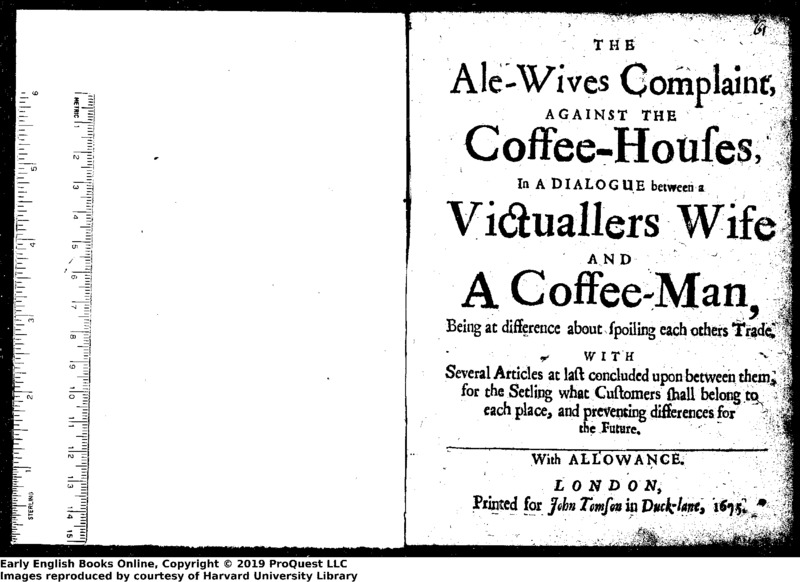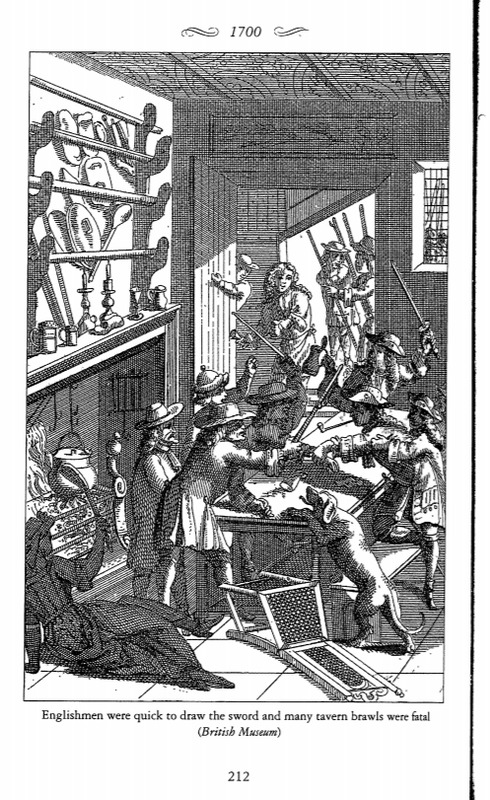Manners of the Tavern, or the Lack Thereof
The surge of British coffeehouses in the 18th century was contrasted with the remnants of the traditional British alehouse. This primary source dated in 1675, and printed in London, showcases tension between one of the earliest pre-18th-century coffeehouses and a tavern which sold alcohol. The subtitle of the document reads “Being at difference about spoiling each others Trade” with articles pertaining to the settling of differences between the two. In the document, the tavern owner in particular was angry about the perceived loss of business due to the rise of the coffeehouse. The differences in the values of the alehouse and the coffeehouse is also on display. The alehouse's wife tells the coffee man "Do you not decoy them with newes, and make them sit till midnight tattling of idle stories, that they neither understand nor are concern'd in." She was criticizing the news sharing associated with the coffeehouses by describing it as an annoyance and a distraction. The coffeeman defends his trade by describing his patrons positively "Our guests are the sober and ingenious, that come not so much to ingurgitate vast quantities of stupifying liquor as to enjoy society and good discourse." No where is the divergence between coffeehouses and alehouses more pronounced. Tavern-goers went to get drunk, and coffee-goers went to enjoy the discourse and presence of their countrymen.
In the text of the document, after the exchange of insults, the two groups come together to form a set of rules which could be used to keep the peace between them. One of these rules was that “any person being reelingly drunk may be entertain’d in a Coffee-house to make himself sober, at which the Ale-house shall take no exception, but rather indeavour in brotherly kindness to make as many as they can so, to increase the Manufactory of Coffee.” The mutualism displayed represents the ways the two sought to coexist to allow each other to thrive economically as equals despite their differences.
The traditional British tavern had a reputation for being a rowdy and rambunctious environment full of drunkards and prostitutes. This primary source depicts a British tavern and focuses on the evil effects it had on men's consciences. The image was created in 1757, and the source says it was most likely created in London. The image is titled “Court Manners or Tavern Rioters.” The images showcase frustration by sober people directed at the rowdy drunkard's. One man says “I’ll have you in y stocks for getting drunk!” and the man who says this is depicted as having the head of a beast for interrupting the fun of the drunkards. It is clear that no intellectual conversations were going on in this establishment. Another man says “I’ll leave, ye, why they’re ruder than Bears, make em’ be quiet sir.” The source provides no background information of the history behind the image, yet because this image was made in 1757, when coffeehouses were well-established, it seems likely it was made to paint taverns in a negative light in order to attract people to coffeehouses as an alternative.
Despite hosting sometimes fiery and intense discussions, the coffeehouses were considerably less violent than their tavern predecessors. This is largely due to the lack of alcohol. This may contribute to the idea that coffeehouse reduced men’s masculinity. In this image from 1700, the violence of taverns was on full display. Author Maureen Waller described the situation in British alehouses, “Fueled by alcohol, fights were frequent and sometimes ended tragically" and "Stolen goods found their way to alehouses and taverns” (Waller, 211). In this image, men brandishing swords are scrambling around and we can infer they got into a petty, drunken argument which they are attempting to settle through violence. With the advent of the coffeehouse, people still gathered to drink in a similar manner but with cooler heads. “Coffee offered a new social beverage which could be drunk in public settings like ales, beers, or wines, but it could be consumed without fear of consequent intoxication” (Cowan 2005, 32).



